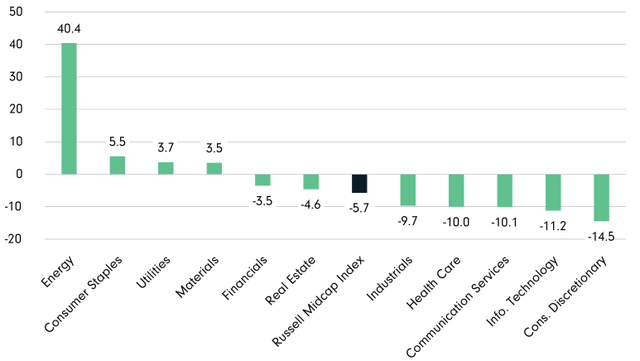Umnat Seebuaphan/iStock via Getty Images
Market Commentary
A wild quarter in equity markets ended in the worst returns since Q1 2020. Rising inflation drove the Federal Reserve to begin its rate hiking cycle, while Putin’s invasion of Ukraine sent commodity prices surging (learn more about the war’s agricultural impact in our recent podcast) and an already challenged supply chain system into further disarray. After the Fed raised rates in March, some optimism crept back into markets as investors viewed the sell-off as an opportunity to gobble up stocks that sold off sharply in January and February.
The Russell 1000 Index closed the quarter down -5.13%. Returns were weaker down the market-cap spectrum as the Russell Midcap Index fell -5.68% and the Russell 2000 Index declined -7.53%. Across the cap spectrum, stocks in the value indexes held up far better than their growth index peers. The Russell 1000 Value Index outpaced its growth counterpart by 830 basis points (bps), while the Russell Midcap Value and Russell 2000 Value Indexes outpaced their growth counterparts by more than 1,000 bps each.
In the Russell Midcap Index, the energy sector advanced 40% as the Russia/Ukraine war and sanctions on the Russian energy sector sent oil and gas prices skyrocketing in Q1. Brent crude reached a high of $140 per barrel in early
March, a level not seen since the global financial crisis in 2008. In the US, gasoline prices jumped past $4 per gallon, with expectations that prices could reach $5 over the next six months. (Learn more about the state of energy marketsin our latest industry perspective.) Consumer staples, utilities and materials all posted single-digit gains in Q1.
Team
Consumer discretionary was the worst performing sector, down -14%, followed by technology (-11%) and communication services (-10%). Financials and real estate outpaced the index, but still posted single-digit declines.
1Q22 Russell MidcapIndex Sector Returns (%)
Source: FactSet, as of 31 Mar 2022.
Performance Discussion
Amid a rocky market quarter overall, our portfolio’s negative returns still outpaced the Russell Midcap Index by a healthy margin in Q1. Relative performance was aided by our underweight exposure to technology, which took a beating in the first half of the quarter, as well as strong performances among our holdings which posted positive returns in aggregate. Our financials and industrials exposures were also additive. On the downside, our underweight to energy weighed on results. Our overweight to the underperforming consumer discretionary sector was an additional source of relative weakness.
On an individual holdings’ basis, top contributors to return in Q1 included Archer Daniels Midland (ADM), Check Point Software Technologies (CHKP) and Alleghany Corporation (Y). ADM is a leading agricultural processor that also operates a global nutrition business focused on the development of ingredients and flavors for food and beverages, supplements and more. The company’s recent operating results have benefited (unfortunately) from the war in Ukraine as grain prices and agricultural markets globally experienced strong price increases. ADM is positioned well to benefit from the volatility due to its stable North American agricultural base.
IT security solutions provider Check Point Software Technologies is making solid progress on its transition toward a subscription-based sales model. We view this as a quality business with strong free cash flow generation (even more so as it generates increasing levels of recurring, subscription-based revenues), high margins and a sticky customer base. It also has a strong balance sheet and a shareholder-oriented management team with a history of great capital allocation. Check Point also received more investor interest following Russia’s invasion of Ukraine and concerns about the potential for related cybersecurity attacks.
Shares of property and casualty insurance firm Alleghany Corporation got a boost as the company announced it agreed to be acquired by Berkshire Hathaway (BRK.A, BRK.B) for a 25% premium to its prior market value.
Other top contributors included Coterra Energy (CTRA) and Freeport-McMoRan (FCX). Energy exploration and production company Coterra benefited from increased energy demand as COVID-related economic restrictions eased in tandem with concerns regarding supply interruptions related to Russia’s invasion of Ukraine. Similarly, copper-focused mining company Freeport-McMoRan benefited in Q1 from rising demand for conductive metals along with supply risk concerns.
Bottom contributors in Q1 included NVR, Inc. (NVR), Colfax Corporation and UGI Corporation (UGI). Homebuilder NVR, along with other housing companies, was pressured in Q1 primarily on concerns that rising mortgage rates will dampen new home demand. We recognize the challenges presented by a rising interest rate environment in the near term. Longer term, the secular outlook on housing construction is positive, as there remains a material shortage of housing stock in the US. We also like NVR’s approach in which it has an option on land rather than owning it outright, which exposes the company to less risk from falling land prices.
Diversified technology company Colfax Corporation underperformed largely due to concerns surrounding the company’s exposure to Russia in its fabrication technology business, which generated about 7% of that business line’s revenue. Just after the quarter’s end, the company completed a planned split-the fabrication technology business becoming ESAB and the medical technology business organized as Enovis (ENOV). ESAB (ESAB) has removed Russia from its guidance for 2022, and with the split finalized, we continue to hold both, believing the two new companies are in an excellent position to leverage their business systems to continuously improve operations over time and engage in value-creating acquisitions in their respective industries.
Taking a cue from the energy crisis in Europe, investors are questioning whether UGI Corporation, a natural gas and electric power utility, may mismanage commodity risk or face some demand destruction. We believe these risks are transient and manageable. What’s more, UGI has made significant investments in its renewable fuels business, including renewable natural gas (RNG) and bioLPG- propane produced from renewable sources such as plant and vegetable waste material.
Other bottom contributors included SVB Financial Group (SIVB) and First Republic Bank (FRC). Innovation-economy focused bank SVB Financial Group was doubly punished as financials traded down and the sell-off in technology raised concerns about slower growth for this niche bank in the near term. First Republic bank also traded down in sympathy with financials, but additionally suffered from uncertainty in the executive suite. The founder went on medical leave, only to have his co-CEO leave the company. Ultimately, the founder returned and a new, permanent CEO was announced. We continue to like both of these banks, as they have distinguished themselves with specialized niches and strong geographic footprints, and they have demonstrated their ability to compound returns and grow intrinsic value over time.
Portfolio Activity
New holdings in the portfolio in Q1 included Allegiant Travel Company (ALGT) and SS&C Technologies (SSNC).
Shares of airline operator Allegiant came under pressure starting in Q4 from the rising omicron wave. Subsequently, share prices were further pressured by rising fuel prices driven, in part, by Russia’s invasion of Ukraine. We took the opportunity of near-term weakness to initiate an investment at what appeared to be an attractive discount to our estimate of intrinsic value. We believe Allegiant remains well positioned to benefit from pent-up demand. Leisure travel, where Allegiant is focused, has been recovering first, and Allegiant is differentiated by a more flexible route structure than peers.
SS&C Technologies Holdings is the world’s largest hedge fund and private equity administrator. SS&C provides important, hard-to-replicate services to its end markets, evidenced by its high level of recurring revenues and strong client retention. The company has shareholder-oriented management and a demonstrated track record of growing free cash flow through skillful acquisitions, sales execution and cost discipline.
Webster Financial Corporation (WBS) is also a new name in the portfolio, having completed its merger with our prior holding Sterling Bank. The combination means that Webster’s large health savings account (HSA) platform, which is a good source of low-cost deposits, will be paired with Sterling’s organic loan generation engine.
We exited Reinsurance Group of America (RGA) and Molson Coors (TAP) in favor of higher conviction names.
Market Outlook
After a strong rebound in 2021, global GDP growth is expected to moderate in 2022, with the potential for additional pressure from lingering supply chain disruptions, higher oil prices, and other impacts from Russia’s invasion of Ukraine. Despite these headwinds, corporate earnings are expected to continue making new highs in 2022.
The sharp economic rebound in the US, along with unprecedented fiscal and monetary stimulus, an uptick in wage growth and instances of supply/demand tightness, has resulted in elevated inflation levels. The Federal Reserve has started to raise interest rates and end quantitative easing but may need to be more aggressive if inflation persists at elevated levels, which could be a headwind for equity markets.
Russia’s invasion of Ukraine has the potential to disrupt the flow of exports from these countries, which may impact global supplies and prices for a wide variety of end markets. The potential impact to individual businesses varies, and we are monitoring these risks closely.
While the year-to-date pullback in equity markets has created some investment opportunities, broad market valuations remain above historical averages. From current levels, equity market returns over the next five years are likely to be below historical averages.
Our primary focus is always on achieving value-added results for our existing clients, and we believe we can achieve better-than-market returns over the next five years through active portfolio management.
Mentioned Securities and Respective Weights (%)
| Alleghany Corp. | 2.1 |
| Allegiant Travel Co. | 0.8 |
| Archer-Daniels-Midland Co. | 1.4 |
| Check Point Software Technologies Ltd. | 3.3 |
| Colfax Corp. | 4.1 |
| Coterra Energy, Inc. | 2.0 |
| First Republic Bank | 2.5 |
| Freeport-McMoRan, Inc. | 3.3 |
| NVR, Inc. | 2.3 |
| SS&C Technologies Holdings, Inc. | 1.0 |
| SVB Financial Group | 3.0 |
| UGI Corp. | 2.0 |
| Webster Financial Corp. | 2.9 |
| Period and Annualized Total Returns (%) | Since Inception (31 Dec 2013) | 5Y | 3Y | 1Y | YTD | 1Q22 |
Expense Ratio (%) |
| Class I (MUTF:DHPIX) | 8.92 | 8.80 | 11.71 | 12.77 | -2 | -2.41 | 0.78 |
| Russell Midcap Index | 11.16 | 12.62 | 14.89 | 6.92 | -6 | -5.68 | – |
| Russell Midcap Value Index | 9.97 | 9.99 | 13.69 | 11.45 | -1.82 | -2 | – |
Editor’s Note: The summary bullets for this article were chosen by Seeking Alpha editors.


Be the first to comment